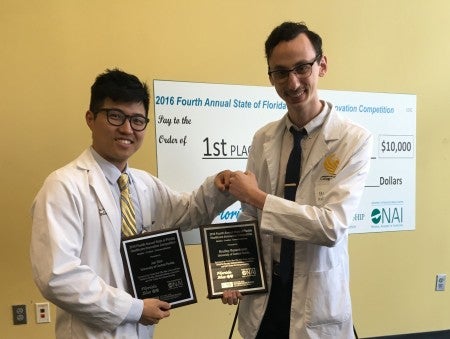A UCF medical student has won a statewide innovation and entrepreneurship award for a computerized imaging process that could help doctors diagnose diseases of the eye earlier and more accurately. The technology is the second medical invention of Jae Kim, a Class of 2017 student who earned his Master’s degree in electric engineering at UCLA before training to be a physician.
His eye diagnostic tool placed first in the annual Healthcare Innovation Pitch Competition at the University of South Florida April 6, earning Kim a $10,000 prize. The competition was open to graduate and undergraduate students across Florida with an invention that could address a significant healthcare challenge. Kim was one of two UCF medical students whose inventions were selected for final presentations to healthcare experts and executives from the National Academy of Inventors, Florida Blue and USF’s Center for Entrepreneurship. Each finalist had just eight minutes to make their pitch, explain their invention and the problem it solves and answer questions. UCF first-year M.D. student Bradley Rosenkrantz presented his device to automate the design of prosthetics.
Kim created a computerized algorithm that analyzes images of the eye to better compare differences as patients with conditions like glaucoma and diabetic retinopathy progress. Currently, physicians use an opthalmoscope to examine the eye, take photos and compare the latest images to past ones. But physicians must rely on their own vision to make comparisons. Kim’s computerized software overlays the images and highlights the differences in a different color, making the analysis more precise and less subjective.
Kim said the invention can be especially helpful to primary care physicians, the first line of defense in eye disease. A recent study found that more than 50 percent of such physicians say they lack confidence in their ability to diagnose eye conditions. As a result, many wait to see if the condition progresses or refer their patients to specialists, which can be costly and delay treatment. Adding to the problem is the fact that less than 50 percent of Americans get an annual eye exam. As a result, many conditions, like diabetes and glaucoma, cause blindness and impaired vision because they aren’t diagnosed until the eye is already damaged.
Kim said he used eye disease as an example for his algorithm but that the technology could be applied to other imaging like X-rays and brain scans. One day, he said, the technology might allow patients to take a photo of their eye with their cell phone and email it to the doctor for analysis.
“When I see something and feel like there has to be a better way, it triggers my curiosity,” he said.
That curiosity has served Kim well at the College of Medicine. He was drawn to the new school because of its Focused Inquiry and Research Experience (FIRE), a two year module where every student must conduct scientific research. After seeing his brother-in-law struggle with gout, a painful form of arthritis triggered by high uric acid in the blood, Kim created during FIRE a machine that can detect uric acid levels at home through the use of light – without drawing blood. Kim hopes his prototype can get into clinical trials to improve the quality of life for people with gout by helping them know earlier when their uric acid levels are increasing so they can take appropriate dietary steps.
That invention was named best research in the Surgery/Biomedical Category at the American Medical Association’s 13th annual Research Symposium in Atlanta in 2015 and also was recognized by the Florida Medical Association.
Kim is currently finishing his third-year clerkships and while he hasn’t chosen a specialty yet, he says interacting with patients has been his favorite activity. “As someone who is always looking for the exact answer, working with patients is unpredictable,” he said. “But it’s so genuine.”
